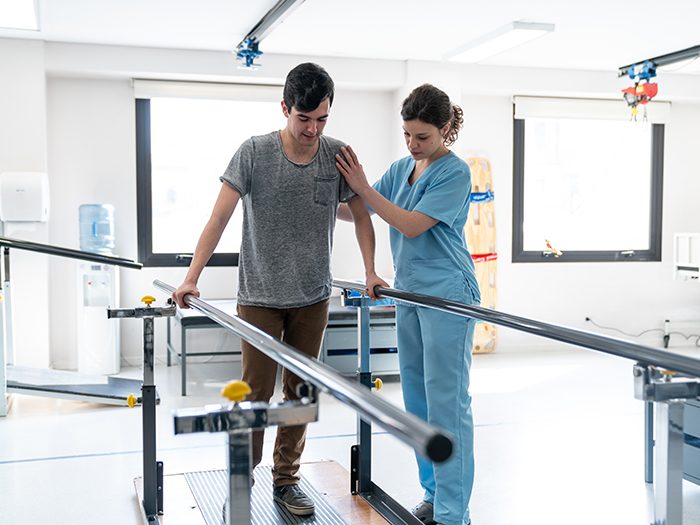Physical Therapy Is a Workers’ Compensation Game Changer. But Only If All Stakeholders Collaborate

When a worker is injured, the implications go far beyond their inability to perform professionally. A debilitating injury means an incapacity to live their day-to-day life as they desire.
“It’s not just about getting the injured worker back to their job but getting them back to doing the things they love, from holding their grandchildren to riding their motorcycle,” said Brian Murphy, vice president of clinical services, ResultsPhysiotherapy, during a recent webinar.
In order to achieve this goal, a streamlined, successful claims process needs to take place.
This includes solid collaboration from all parties involved when a worker falls ill or gets hurt. But how can everyone from third party administrators to physical therapists ensure that this collaboration remains at the forefront of the claim?
To address this issue, One Call hosted a webinar on January 26 titled, “Collaboration: The Key to Successful PT Claim Outcomes.” The discussion featured a wide range of perspectives from professionals in the workers’ compensation industry, each who play a definitive role in an injured worker’s claim.
Ultimately, the goal among each party, which includes the employer, third party administrator, provider, care coordinator and physician, remains absolute: Producing the best performance outcome for the patient. Poor collaboration yields delays in care, effectively hindering an injured worker’s chance for optimal recovery.
“When collaboration doesn’t exist, everything becomes elongated,” said another webinar panelist, Linda Lane, president of physical therapy, One Call.
Addressing Barriers
Of course, this collaborative process is not without its challenges. There are barriers when it comes to perfecting, and sometimes readjusting, an injured worker’s recovery plan. Fortunately, a shift in the workers’ comp industry has made these barriers less daunting.
A third webinar speaker, Julie Fischer, assistant vice president of medical programs at ESIS, praised the industry for its transition to an advocacy approach when processing claims: “It’s not just a procedural process anymore,” she said.
Fischer continued delving into the barriers that a patient can unknowingly inflict on themselves, an aspect of recovery all parties should consider.
These include physical barriers, such as a patient’s fear of physical therapy, mental barriers, like a cautiousness about recovery and personal barriers, where a patient feels a lack of confidence in their chances of recovery.
This brings to light another aspect of an injured worker’s journey that can be forgotten by the industry; their vulnerability. It also emphasizes why collaboration is so necessary.
In order to combat these particular roadblocks, it’s crucial that every party remains engaged throughout the entire treatment and recovery process. This includes the injured worker themselves.
Murphy touched on the importance of this aspect, saying that the injured worker plays an essential role in a successful recovery. The effects of a positive collaboration will not only help the injured worker recognize their contributions but also “actively participate in getting better,” he noted.
Finally, a barrier that has potential to arise in treatment is mistrust between patient and physician, which could hinder recovery.
“If you have a patient that trusts their provider, and there’s empathy in the messaging, the patients are going to want to get better because they know they’re in the right hands,” said Dr. Craig Uejo, medical director of occupational health and safety, Scripps Health, another presenter for the webinar.
He continued, “but not if there’s a lack of that trust.”
The Use of Data in Producing Positive Outcomes
The ability to utilize data has become an integral part of determining best outcomes for injured workers. In many cases, data also displays the connection between behavioral health and physical health, which was not recognized by the industry 10 years ago, Lane noted.
A fifth and final speaker, Michelle Despres, vice president of physical therapy for One Call, touched on the company’s at-risk program, which analyzes the psychosocial factors of an injured worker in order to determine the longevity of their case.
Additionally, the data use allows for the doable merging of all stakeholders on that specific injured worker’s treatment plan.
Data is also utilized to stress the importance of early physical therapy treatments. Murphy noted several studies that concluded “workers who receive physical therapy promptly are less likely to use opioid medications, need surgery and so on,” he said.
In terms of fiscal benefits, studies have shown that a quicker start to physical therapy could save an injured worker approximately $2,700 on treatment.
Finally, the use of data enables all parties to create and implement an individualized recovery plan for the injured worker. This also calls for a collaborative approach, especially if recovery is not moving along as it should. Data makes it so that professionals can see which methods have been successful for previous cases.
Fischer commented, “Each claim can be unique in their recovery. Ask ‘What is working across the business?’ ”
So, What Does A Good Outcome Look Like?
The discussion asked panelists what a good outcome for an injured worker looks like from each parties’ standpoint.
For employers, it’s an injured worker’s return to work.
For third party administrators, a good outcome is a case that keeps moving and eventually closes, knowing that the patient’s recovery was achieved. Fischer also noted the importance of reviewing the case’s data, specifically the duration and cost of treatment. Third party administrators are now placing a higher focus on ensuring injured workers are assisted as much as possible.
Physical therapists and physicians deem it a good outcome if the injured worker returns to functionality. This all stems from an early introduction to physical therapy and not necessarily focusing on the pain but celebrating the small accomplishments in the worker’s recovery.
These small accomplishments are only seen as achievements if the injured worker feels motivated to heal. After all, they do play a big role in the process. &










